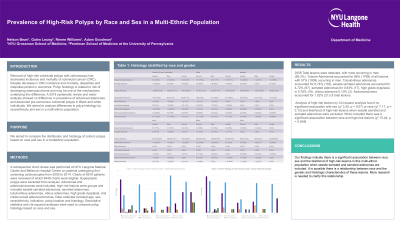Tuesday Poster Session
Category: Colorectal Cancer Prevention
P3167 - Prevalence of High-Risk Polyps by Race and Sex in a Multi-Ethnic Population
Tuesday, October 24, 2023
10:30 AM - 4:00 PM PT
Location: Exhibit Hall

Has Audio
- NB
Nelson M. Bean, MD, MPH
NYU Langone Health
New York, NY
Presenting Author(s)
Nelson M. Bean, MD, MPH1, Leung Galen, MD2, Renee Williams, MD, MHPE1, Adam J. Goodman, MD1
1NYU Langone Health, New York, NY; 2University of Pennsylvania Perelman School of Medicine, Philadelphia, PA
Introduction: Removal of high-risk colorectal polyps with colonoscopy has decreased incidence and mortality of colorectal cancer (CRC). Despite decrease in CRC incidence and mortality, disparities and inequities persist in outcomes. Polyp histology is related to risk of developing adenocarcinoma and may be one of the mechanisms underlying this difference. A 2018 systematic review and meta-analysis showed no difference in prevalence of advanced adenomas and advanced pre-cancerous colorectal polyps in Black and White individuals. We aimed to analyze differences in polyp histology by race/ethnicity and sex in a multi-ethnic population.
Methods: A retrospective chart review was performed at NYU Langone Medical Center and Bellevue Hospital Center on patients undergoing first screening colonoscopies from 2000 to 2014. Charts of 8519 patients were reviewed of which 6449 charts were eligible. Hyperplastic polyps were excluded from analysis. Adenomas and adenocarcinomas were included, high risk lesions were grouped and included sessile serrated adenomas, serrated adenomas, tubulovillous adenomas, villous adenomas high grade dysplasia, and intramucosal adenocarcinomas. Data collected included age, sex, race/ethnicity, indication, polyp location and histology. Descriptive statistics and chi-squared analyses were used to compare polyp histology based on race and sex.
Results: 2056 total lesions were detected, with most occurring in men (56.3%). Tubular adenomas accounted for 86% (1769) of all lesions, with 57% (1009) occurring in men. Tubulovillous adenomas accounted for 5.74% (118), sessile serrated adenomas accounted for 4.72% (97), serrated adenoma for 0.83% (17), high grade dysplasia in 0.78% (16), villous adenoma 0.10% (2). Adenocarcinoma accounted for 1.02% (21) of total lesions. Analysis of high-risk lesions by Chi-square analysis found no significant association with sex (χ2 3.20, p = 0.07) or race (χ2 7.17, p = 0.13) and likelihood of high-risk lesions when sessile serrated and serrated adenomas were excluded. When included there was a significant association between race and high-risk lesions (χ2 15.44, p = 0.004).
Discussion: Our findings indicate there is a significant association between race, sex and the likelihood of high-risk lesions in this multi-ethnic population when sessile serrated and serrated adenomas are included. It is possible there is a relationship between race and the genetic and histologic characteristics of these lesions. More research is needed to clarify this relationship.
Disclosures:
Nelson M. Bean, MD, MPH1, Leung Galen, MD2, Renee Williams, MD, MHPE1, Adam J. Goodman, MD1. P3167 - Prevalence of High-Risk Polyps by Race and Sex in a Multi-Ethnic Population, ACG 2023 Annual Scientific Meeting Abstracts. Vancouver, BC, Canada: American College of Gastroenterology.
1NYU Langone Health, New York, NY; 2University of Pennsylvania Perelman School of Medicine, Philadelphia, PA
Introduction: Removal of high-risk colorectal polyps with colonoscopy has decreased incidence and mortality of colorectal cancer (CRC). Despite decrease in CRC incidence and mortality, disparities and inequities persist in outcomes. Polyp histology is related to risk of developing adenocarcinoma and may be one of the mechanisms underlying this difference. A 2018 systematic review and meta-analysis showed no difference in prevalence of advanced adenomas and advanced pre-cancerous colorectal polyps in Black and White individuals. We aimed to analyze differences in polyp histology by race/ethnicity and sex in a multi-ethnic population.
Methods: A retrospective chart review was performed at NYU Langone Medical Center and Bellevue Hospital Center on patients undergoing first screening colonoscopies from 2000 to 2014. Charts of 8519 patients were reviewed of which 6449 charts were eligible. Hyperplastic polyps were excluded from analysis. Adenomas and adenocarcinomas were included, high risk lesions were grouped and included sessile serrated adenomas, serrated adenomas, tubulovillous adenomas, villous adenomas high grade dysplasia, and intramucosal adenocarcinomas. Data collected included age, sex, race/ethnicity, indication, polyp location and histology. Descriptive statistics and chi-squared analyses were used to compare polyp histology based on race and sex.
Results: 2056 total lesions were detected, with most occurring in men (56.3%). Tubular adenomas accounted for 86% (1769) of all lesions, with 57% (1009) occurring in men. Tubulovillous adenomas accounted for 5.74% (118), sessile serrated adenomas accounted for 4.72% (97), serrated adenoma for 0.83% (17), high grade dysplasia in 0.78% (16), villous adenoma 0.10% (2). Adenocarcinoma accounted for 1.02% (21) of total lesions. Analysis of high-risk lesions by Chi-square analysis found no significant association with sex (χ2 3.20, p = 0.07) or race (χ2 7.17, p = 0.13) and likelihood of high-risk lesions when sessile serrated and serrated adenomas were excluded. When included there was a significant association between race and high-risk lesions (χ2 15.44, p = 0.004).
Discussion: Our findings indicate there is a significant association between race, sex and the likelihood of high-risk lesions in this multi-ethnic population when sessile serrated and serrated adenomas are included. It is possible there is a relationship between race and the genetic and histologic characteristics of these lesions. More research is needed to clarify this relationship.
Disclosures:
Nelson Bean indicated no relevant financial relationships.
Leung Galen: Boston Scientific Corporation – Consultant. Steris – Consultant.
Renee Williams: Boston Scientific – Stock-publicly held company(excluding mutual/index funds). Janssen – Advisory Committee/Board Member. Universal Diagnostics – Advisory Committee/Board Member, Consultant.
Adam Goodman: Ambu, Inc – Consultant. Boston Scientific – Consultant.
Nelson M. Bean, MD, MPH1, Leung Galen, MD2, Renee Williams, MD, MHPE1, Adam J. Goodman, MD1. P3167 - Prevalence of High-Risk Polyps by Race and Sex in a Multi-Ethnic Population, ACG 2023 Annual Scientific Meeting Abstracts. Vancouver, BC, Canada: American College of Gastroenterology.
